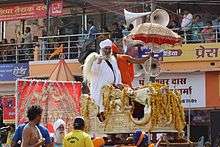Nirmala (sect)

Nirmala is an Indian religious sect of ascetics. The Nirmalas claim origin from the Sikh Gurus.
Origin
The Nirmalas themselves claim to have originated from Guru Nanak, the first Sikh Guru . One legend claims that the distinct Nirmala identity was established by a group of scholars, whom Guru Gobind Singh sent to Kashi to learn Sanskrit.[1] After mastering Sanskrit in Kashi, they returned to Anandpur, where they were honoured by the title Nirmala (Sanskrit for "pure" or "unsullied").[2] After Gobind Singh's evacuation from Anandpur, they spread to different parts of India. W. H. McLeod (1995) doubts the historicity of this legend, arguing that there are very few mentions of Nirmalas before the 19th century. Pashaura Singh and Louis E. Fenech hypothesize that the Nirmalas are descended from the Udasis, who are similar to them in ascetic lifestyle, celibacy and Vedantic interpretation of Sikh philosophy.[3]
History
Patronage from Sikh nobles, especially the rulers of the Phulkian states, helped the Nirmalas become a prominent religious order.[3] Sardar Dhyan Singh of Shahbad willed his estate to Karam Singh Nirmala. In 1766, Sadda Singh of Bahirwala offered seven villages to Bhagat Singh Nirmala, although the latter declined the offer. Sardar Jai Singh's daughter-in-law granted two villages to the Nirmal Dera at Kankhal.[1]
Sardar Ganda Singh of Bhangi Misl offered 13 villages to Jai Singh Nirmala. In 1796, Maharaja Ranjit Singh also granted a sanad for land to Nihal Singh Nirmala. On both occasions, the Nirmalas passed on the properties to the Udasi akhara of Santokh Das.[1]
Philosophy and practices

Like the Udasis, the Nirmalas interpret the teachings of the Sikh Gurus in context of Vedanta. However, compared to the Udasis, they have shared a closer relationship the mainstream Khalsa Sikhs. Many prominent Nirmala sants preached mainstream Sikhism in Punjab, and Nirmala akharas have played an important role in training Sikhs. But after the Akali movement, the Khalsa attempts to create a Sikh identity completely distinct from Hindus made the Khalsa-Nirmala relationship fragile.[3]
Locations
The Nirmala Panchaati akhara at Kankhal, established with grants from the rulers of Phulkian states, has the highest status among all Nirmala chapters.[3] Other major Nirmala centres are located at Haridwar, Allahabad, Ujjain, Trimbak, Kurukshetra and Patna.
Notable Nirmalas
- Pundit Tara Singh (1822–1891), Punjabi and Sanskrit scholar
- Kahn Singh Nabha, Prominent Sikh Scholar
- Balbir Singh Seechewal, Prominent environmentalist
References
- 1 2 3 Surjit Singh Gandhi (2007). History of Sikh Gurus Retold: 1606-1708 C.E. Atlantic. pp. 971–974. ISBN 9788126908585.
- ↑ Bhagat Lakshman Singh (1995). Short Sketch of the Life and Works of Guru Gobind Singh. Asian Educational Services. p. 67. ISBN 9788120605763.
- 1 2 3 4 Pashaura Singh; Louis E. Fenech (2014). The Oxford Handbook of Sikh Studies. OUP Oxford. pp. 377–378. ISBN 978-0-19-100412-4.